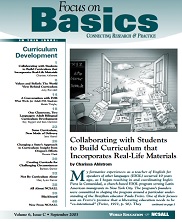Curriculum is at the heart of adult basic education. It reflects our educational philosophy and beliefs about the goals of education. What are the different philosophical approaches to curriculum? What does research tell us about curriculum? How do teachers, programs, even states go about creating curriculum, and what lesson can we learn from them? In this issue of Focus on Basics, we explore those questions.
In our cover article, Massachusetts teacher Charissa Ahlstrom describes how she develops her curriculum as she goes, based on her students’ interests, working within a loose framework developed by her program. She brings in “real life” materials that connect the classroom to students’ day-to-day lives. The classroom-to-real-life connection is important, according to research teams led by Victoria Purcell-Gates and Heide Spruck Wrigley (see pages 5 and 13). How do you bring the outside into your curriculum?
Different approaches to curriculum reflect different world views, writes Amy Prevedel in her overview of key curriculum theories (see page 8). She describes three major categories of curriculum—traditional, learner-driven, and critical—and the strength and weaknesses of each. Into which category does your approach fall?
Kay Taggart and Sara Martinez help teachers in El Paso, Texas, understand how to optimize the impact of bilingual curricula (see page 18). The judicious use of English along with students’ native language leads to conceptual understanding and communicative competence. Wrigley’s research (page 13) reinforces this: students in classes of English for speakers of other languages had higher gains when they shared a language and the teacher used the language to give instructions or to clarify points.
How does curriculum change when the mode of delivery changes? That’s the issue Jane Martel and her colleagues faced when Kentucky’s professional development for adult basic education went online. Benefit from the lessons they learned by reading the article that begins on page 22. And while Kentucky was converting its professional development curriculum, Oregon was revising its adult basic education curriculum. How does a state change curriculum? It takes policy, practice, and professional development. Teacher Dennis Clark shares his experiences as a leader in that process in the article that starts on page 26.
Sometimes the context has a huge impact on the shape a curriculum takes. That was the case in Guinea, West Africa, where I worked with World Education colleagues to develop a basic literacy program for adults. Turn to page 30 to read about how we managed to reflect our educational values in a resource-poor environment.
When your learners are not making the progress they should, it’s time to look at curriculum, writes Mary Lynn Carver, a teacher in Illinois, in the article that begins on page 32. Curriculum change in her program spread from individuals to the system, and encompassed not just what was taught but how classes were scheduled.
Whatever your philosophy and approach to curriculum, we hope this issue provides you with insights and resources you need to strengthen your program. World Education, 2003.


